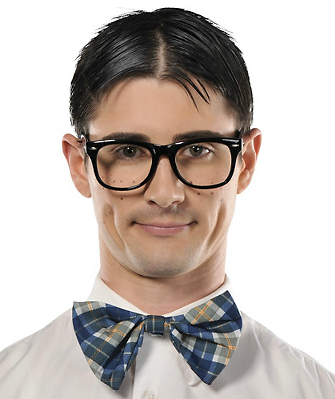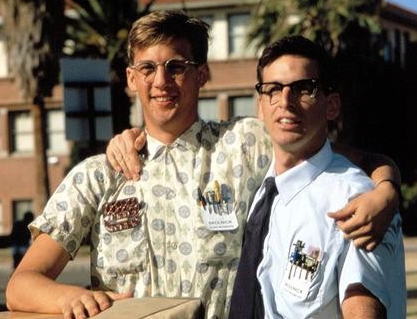Nerd glasses.
Readers familiar with my column (you guys exist, right?) know what that phrase means to me, and my long and antagonistic history with the Geek Chic trend of the 2000s. I’ve covered its’ rise and fall: How the omnipresence of technology over the course of the 1990s led to a reassessment of the role of techno-fiends in the early 2000s, how that reassessment briefly led to an unironically ironic appreciation for “nerd” types, and how that appreciation was expressed in the adoption of typically “geek” clothing, particularly the stereotypical dark rimmed glasses. For all of my coverage, though, one piece of the puzzle has long remained missing: Although we can be sure of where the geek chic trend came from, where did geek come from? The name itself began as an insult to those perceived as socially maladjusted—before its current application, “geek” was the name given to Depression-era carnival performers who bit the heads off of (often live) chickens. Where did the geek image come from, though? How did dark-rimmed glasses so deeply entrenched in the public subconscious as an indicator of technological savvy and social incompetence?

In deciding to write this column, I was ready for a maelstrom of academic research, anticipating a grueling slog through sociological research papers and academic treatises that threatened to bury me for months on end. It was a potentially daunting undertaking, and for a while I was hesitant to get it underway. Then, a tremendous breakthrough came, a piece of research priceless to the integrity of the project.
Which is to say, someone else figured it out first.
I’ve never been reticent to give credit in the past to those individuals who’ve helped me research articles or who’ve given me valuable information; their names usually pop up at the bottom of my columns in italic post-script sections. This time around, I’ve got to give an in-text shout out to Joal Ryan. Unlike most of the other men and women who’ve contributed valuable information to my columns, Mr. Ryan’s name probably isn’t familiar in the optical world, and for good reason: he’s actually an entertainment reporter. It was Mr. Ryan who unintentionally solved the mystery of the origins of Geek, by, of all things, writing a movie retrospective.
In the course of his work, he observed an interesting phenomenon in Hollywood’s depiction of the socially inept: although the stereotype of the socially inept yet intellectually advanced nerd existed prior to the 1980s, it wasn’t until that decade that the entertainment industry developed a concrete image of what that stereotype should look like. As Ryan pointed out in a recent piece, “Searching for the Roots of the Nerd Look,” prior depictions of geeks were more scattershot, from Grease’s Eugene (an aviators-and-lei wearing outcast) to Jerry Lewis’ Nutty Professor (a figure more inspired by parody of academics) even up to Sixteen Candles’ protagonist named simply “The Geek” (who’s just a creepy kid in an oxford and jeans). Then, in 1984, Revenge of the Nerds was released to theaters, becoming one of the most financially successful comedies in a decade known for financially successful comedies; and while executives counted dollars, movie audiences were unexpectedly getting a subliminal education in stereotypes.

Revenge of the Nerds invented the nerd.
So many people saw the film that the image became emblazoned on the national subconscious as a new cultural archetype (based on the average ticket price of $3.36 in 1984, the film’s $40 million-and-change gross means that roughly 12,172,619 people watched the film that Summer); and although the film was a tremendous box office success, it didn’t quite find its way into the cultural lexicon or memory the way that films such as Casablanca or The Godfather or even Nerds’ contemporary Ghostbusters did. Yet the images the film presented were powerful enough, and resonated enough with audiences that they served to stigmatize a particular aesthetic and more importantly (for us, anyway) an entire style of glasses for nearly 30 years. Heck, by the time I started wearing glasses in the late 90s, the plastic glasses = nerd stereotype still existed, amongst a generation for which Revenge had little relevance; and while numerous styles have been perceived of as outdated (round zyls, particular types of wire rims, etc.) none of those styles carried the generational stigma with which Nerds saddled plastic frames. Were it not for a single film, zyl frames could have easily drifted back into mainstream fashion years sooner; and, failing that, we might at least not have as much difficulty fitting older, high-minus patients into zyls.

Who reading this hasn’t had a patient over the age of forty react vehemently at the suggestion he or she (ok, let’s face it, usually he) try a pair of plastic frames? (Writing this, I wince as I recall the middle-aged dad who lost his cool in our dispensary when his twelve-year-old son tried on a pair of zyl frames after being diagnosed as a myope. “Put those down! No son of mine’s gonna walk around looking like a [expletive deleted] nerd!” Oh, yes. That happened. Then he begged us for contact lenses). It’s something to consider the next time you’re watching a movie or television show, regardless of its’ success or cultural impact: Will something about this particular piece of pop culture strike a chord powerful enough that it will resonate through the years? It’s a sobering thought, not just for those of us in a profession so subject to the fickle influence of the entertainment industry, but to the world at large. The smallest ideas can have the biggest impacts, and what seems, at the time, to be a harmless bit of fun can have painful echoes down through the generations.
The text of Joal Ryan’s complete article can be read here

Preston Fassel was born in Houston, Texas and grew up between St. Charles, Missouri and Broken Arrow, Okla.
In 2009, Preston graduated Summa Cum Laude with a degree in Liberal Arts. In 2011, he graduated Cum Laude from Sam Houston State University with a Bachelor's of Science.
Preston currently works as an Optician in the Houston area. His interest in the history of eyewear goes back to his time in high school, when he developed an interest in all things vintage.
In addition to his writing for The 20/20 Opticians Handbook and 20/20 Magazine, Preston is a featured writer for Rue Morgue Magazine, where he reviews of horror and science-fiction DVDs. His fiction writing has been featured three times in Swirl magazine, the literary arts journal of Lone Star College and Montgomery County. He is the author of the definitive work on the life of British horror actress Vanessa Howard, Remembering Vanessa, which appeared in the Spring 2014 edition of Screem Magazine.
Preston lives in Conroe, Texas with his wife, Kayleigh, and his ego, Ted.












